Hyundai Gets It Right This Time
When we reviewed the first Hyundai Sonata Hybrid after its arrival in February 2011, we noted it was taking direct aim at the Toyota Camry Hybrid and Ford Fusion Hybrid, the two most popular midsize gasoline-electric hybrid sedans at the time. We also said, “Keep your eye on the new kid on the hybrid block.”
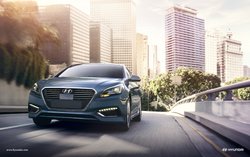
We weren’t wrong, the Sonata Hybrid kicked butt. After only three months on the market, the newbie became the second best-selling hybrid in the U.S., trailing only the indomitable Toyota Prius, a position it maintained through the end of 2011.
The Hybrid’s meteoric rise on the sales chart certainly wasn’t about the car’s fuel economy rating of 35-mpg city/40 highway and 37 combined — there were seven other offerings with higher ratings. Buyers were enticed by the Sonata’s eye-riveting styling and tech-rich standard equipment at a price that was difficult to pass up.
But things change can quickly in the automotive industry. Toyota brought out an all-new Camry Hybrid in 2012 and Ford began selling its all-new Fusion Hybrid not long after, both of which easily trumped the Sonata’s so-so fuel economy.
Additionally, Hyundai’s first hybrid system misfired during city driving, a calamity that was not only off-putting, but a deal breaker for many shoppers. Sales began declining in 2012 and through October of this year, where the Sonata is ranked sixth in overall hybrid sales, trailing both the Toyota and Ford.
MPG Improvement, Now a Smooth Operator
Hyundai introduced an all-new Sonata last year, but waited a year before launching the hybrid version. The wait was worth it; the 2016 Sonata Hybrid is now one of the better choices for a family hybrid sedan.
The 2016 Hyundai Sonata Hybrid is offered in three models: SE starting at $26,835 (including $835 destination charges), Limited priced at $30,935 and a fully loaded Limited with Ultimate
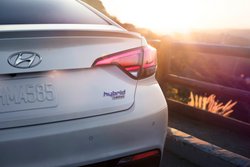
Package that stickers for $35,395.
Criticized for its previous hybrid’s middling fuel economy, Hyundai engineers meticulously rethought and re-engineered the hybrid system that casts aside that criticism. The 2016 Sonata Hybrid SE now has an all-40 MPG government rating —40 city /44 highway /42 combined. The weight of added features and higher rolling resistance of its 17-inch tires penalizes the Limited model, which is EPA rated at 39 city /43 highway /41 combined.
Much of the mpg improvement was achieved by jettisoning the 2.4-liter four-cylinder gas engine of the previous model and downsizing to a more efficient direct-injected 2.0-liter four. Engine output is 154 horsepower and 140 pounds-feet of torque.
Additional gains come from higher voltage for the lithium polymer battery pack and a new electric motor’s remarkable willingness to kick into electric mode, even at 70 mph on the interstate.
To make up the performance slack of the smaller engine, the previous 35-kilowatt electric motor was replaced by a smaller, but more powerful 38 kW unit that generates 51 horsepower and 140 pounds-feet of torque. Under acceleration, the engine and motor pool their resources to provide a combined system output of 193 horsepower. The upshot is performance similar to the outgoing car — about an 8-second zero-to-60 run.
As for the hybrid system’s calamity during in-town driving, Hyundai has ironed out that issue with significant changes to the six-speed automatic transmission, which houses the traction motor. The words to describe the hybrid system are now smooth and seamless.
The South Korean automaker calls the system Hybrid Blue Drive. It’s a full parallel hybrid design that permits operating in three modes: gasoline power, electric-only power and a combination of both.
Like other systems of this type, it has stop-start capability to conserve fuel, as well as regenerative braking that feeds energy to the battery during slowing and braking.
Slick and Slippery
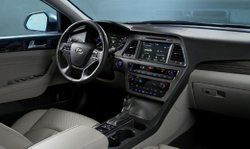
When Hyundai redesigned the Sonata last year, they took a step back from the forward-looking, forward-thinking example of daring and aggressive design of the previous version. The new look is conservative and mature.
With the 2016 Sonata Hybrid, Hyundai put form in the service of function — better aerodynamics. Up front, the grille features active air flaps as well as an “air curtain” method of tuning the front-end to sweep airflow outside to front wheels and over the hood.
Hybrid-specific alloy wheels help diminish wind drag, while a covered undercarriage, a rear spoiler and redesigned rear facia improve downforce. All of these touches add up to a slick and slippery drag coefficient of just 0.24 Cd, matching the Tesla Model S.
Inside there is a delicious amount of passenger space, front and rear, and the car sets a high standard for fit and finish and high-quality materials. A simple horizontal dash affords the driver easy access to controls that are easy to use, with proper buttons for basic functions such as audio entertainment, phone and navigation.
A distinctive instrument cluster with a 4.2-inch color LCD multi-purpose display lets Hybrid drivers know the status and flow of the hybrid system.
The 2016 Sonata Hybrid continues Hyundai’s knack of creating strong showroom appeal by including hot-button features as standard. These include Hyundai’s Blue Link safety, service, and
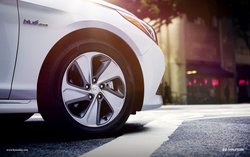
infotainment telematics system as well as Bluetooth hands-free mobile phone linking, and satellite radio. Add to the list an auxiliary audio jack and a USB interface for iPods and other digital media, plus a steering wheel fitted with audio, Bluetooth and cruise controls.
A step-up navigation system, not available on the SE, features a new split-screen mode, HD Radio, support for Pandora, Eyes-Free Siri compatibility along with built-in Apple CarPlay and Android Auto integration.
In case your passengers happen to be toddlers rather than adults, installing car and booster seats in the Sonata Hybrid is a breeze. Plus, there is ample room in the trunk’s 13.3 cubic feet of space to stash strollers and other kid paraphernalia. That’s thanks to Hyundai placing the battery pack under the trunk floor, which allows 60/40 split-folding rear seats.
The Sonata Hybrid’s resume includes a full suite of airbags, a backup camera and stability and traction controls. Optional are forward collision, lane departure and blind-spot warning systems along with rear parking assist with rear cross-traffic warning and active cruise control.
On The Road
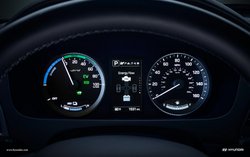
Driving the 2016 Sonata Hybrid is a soothing respite to the bustle and hubbub of city traffic — nicely soundproofed, luxuriously appointed and pleasant to drive. Get up to speed from a stop via the gas engine, ease off the accelerator and the transition to electric power is uncannily smooth and allows all-electric driving for several miles.
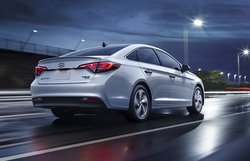
Hyundai’s reason for choosing an automatic transmission rather than the more common hybrid continuously variable transmission (CVT) was to address the complaint that hybrids were boring to drive.
Mash the throttle and the six-speed transmission winds nicely toward top rpms, shifting each time somewhere around 6,000 rpm, when the full tug of torque seems ready to run out. So it would seem that Hyundai’s goal of achieving a driving experience that closely parallels a conventional car is accomplished.
As for handling, the car has balanced agility and the suspension keeps everything secure. The ride is composed and comfortable with the suspension soaking up potholes and rough pavement.
My favorite aspect of the Sonata’s road manners is its responsive steering. It has a quick and precise feeling, is balanced and firm, but never twitchy.
Regenerative and hydraulic braking play a role in the hybrid system, and the brake pedal felt squishy and unnatural, something I couldn’t get used to during our week with the car.
Accelerating moderately and keeping pace with 70-75 mph freeway traffic, after driving 189 miles in our Limited test car nearly equally divided between city and highway driving, we averaged 42.3 mpg. What likely helped beat the EPA rating was the hybrid system’s ability to travel on electric power at 70 mph, something I found fairly easy to do.
In The Marketplace
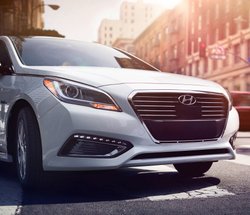
The 2016 Hyundai Sonata Hybrid faces different market conditions than the 2011 model. Its two main competitors, the Fusion Hybrid and Camry Hybrid have now firmly established themselves as competent and reliable vehicles with excellent fuel economy.
Also, 2011 was a high point for gasoline prices, averaging $3.53 per gallon with a peak of more than $4.00. Today, the national average is $2.21, which makes it tough to sell a gasoline-electric hybrid car.
At $26,835 to $35,395, the 2016 Sonata Hybrid isn’t cheap. Ford’s Fusion Hybrid is priced from $24,950 to $30,300, while the Toyota Camry Hybrid runs from $27,640 to $30,990.
But the 2016 Sonata Hybrid offers something the others don’t — Hyundai’s warranty that the carmaker promotes as America’s best. Basic coverage is five-years/60,000-miles bumper-to-bumper and 10-years/100,000-miles powertrain. Owners also receive 24-hour roadside assistance at no extra charge for five-years/unlimited mileage.
Then there’s the warranty knockout punch—the Lifetime Hybrid Battery Guarantee. If the lithium polymer battery fails, Hyundai will replace the battery and cover recycling costs of the old battery pack free of charge to the original owner.
That’s impressive, and it could quite possibly help the Sonata Hybrid to move up the sales chart and become a major player once again.
Related Stories You Might Enjoy:
Top 10 Best-Selling Best Fuel Economy Car
Road Test: 2015 Volkswagen Jetta Hybrid
Road Test: 2015 Honda Accord Hybrid
Road Test: 2014 Toyota Camry Hybrid
Road Test: 2014 Ford Fusion Energi
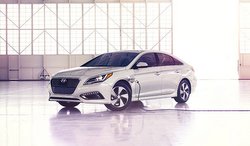
Disclosure:
Clean Fleet Report is loaned free test vehicles from automakers to evaluate, typically for a week at a time. Our road tests are based on this one-week drive of a new vehicle, which does not address issues such as long-term reliability or total cost of ownership. In addition we are often invited to manufacturer events highlighting new vehicles or technology, during which we may be offered free transportation, lodging or meals. We do our best to present our unvarnished evaluations of vehicles and news irrespective of these inducements. Our focus is on vehicles that offer the best fuel economy in their class or are among the top mpg vehicles on the market. In addition, we aim to offer reviews and news on advanced technology and the alternative fuel vehicle market. We welcome any feedback from vehicle owners and are dedicated to providing a forum for alternative viewpoints. Please let us know your views at publisher@cleanfleetreport.com.

0 thoughts on “Road Test: 2016 Hyundai Sonata Hybrid”